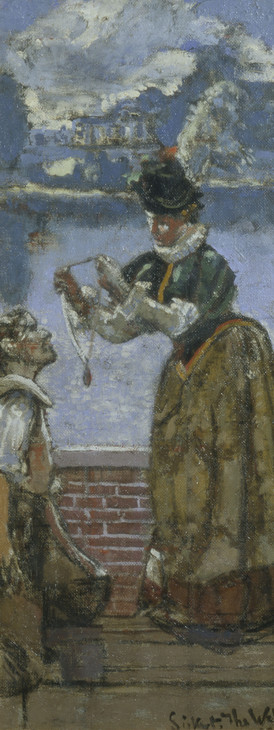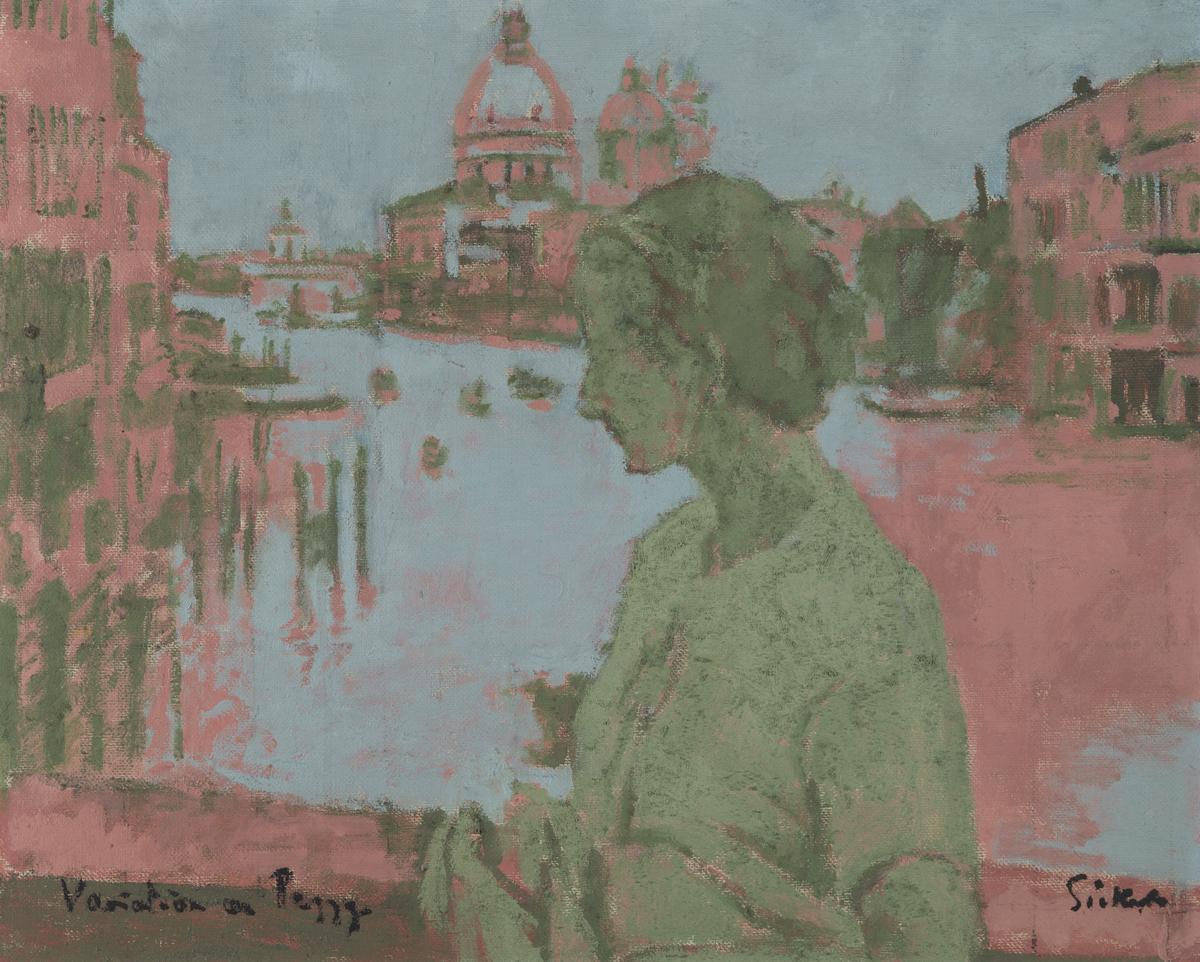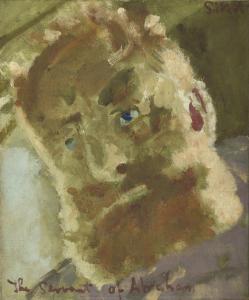Walter Richard Sickert Variation on Peggy 1934-5
Walter Richard Sickert,
Variation on Peggy
1934-5
The setting of this profile portrait of the actress Peggy Ashcroft, in a summer dress with her hair tied in a bun, is the Accademia Bridge in Venice. The silhouette of the church of Santa Maria della Salute is visible across the Grand Canal in the distant background. The painting is based on a black and white press photograph published by the Radio Times in 1934; Sickert’s brash triple-tone colour palette of green, pink and blue is entirely invented. Sickert befriended the young actress when she was beginning to garner success on the stage, and made a number of pictures of her in theatrical roles as well as more casual moments.
Walter Richard Sickert 1860–1942
Variation on Peggy
1934–5
Oil paint on canvas
578 x 718 mm
Inscribed by the artist in black paint ‘Sickert’ bottom right and ‘Variation on Peggy’ bottom left
Bequeathed by Dame Peggy Ashcroft in 1991, accessioned 1992
T06601
1934–5
Oil paint on canvas
578 x 718 mm
Inscribed by the artist in black paint ‘Sickert’ bottom right and ‘Variation on Peggy’ bottom left
Bequeathed by Dame Peggy Ashcroft in 1991, accessioned 1992
T06601
Ownership history
Gift of the artist to the sitter, by whom bequeathed to Tate Gallery 1991 and accessioned 1992.
Exhibition history
1935
New Paintings by Richard Sickert, Beaux Arts Gallery, London, July 1935 (8, reproduced).
1981–2
Late Sickert: Paintings 1927 to 1942, (Arts Council tour), Hayward Gallery, London, November 1981–January 1982, Sainsbury Centre for the Visual Arts, University of East Anglia, Norwich, March–April 1982, Wolverhampton Art Gallery, April–May 1982 (19, reproduced).
2004
Walter Richard Sickert: The Human Canvas, Abbot Hall Art Gallery, Kendal, July–October 2004 (41, reproduced).
2010
The Art of Walter Sickert, The Lightbox, Woking, May–July 2010 (no catalogue).
References
1935
‘An Old Man’s Brilliance’, News Chronicle, 15 July 1935.
1973
Wendy Baron, Sickert, London and New York 1973, pp.177, 388.
1992
Wendy Baron and Richard Thomson (eds.), Sickert: Paintings, exhibition catalogue, Royal Academy, London 1992, p.326, reproduced fig.225.
1994
‘Acquisitions 1990–1991 at the Tate Gallery I: British Collection’, Burlington Magazine, vol.136, no.1098, September 1994, p.660, reproduced.
2002
Rebecca Daniels, ‘The Late Oeuvre of Walter Richard Sickert’, Apollo, vol.156, no.489, October 2002, pp.32–3, reproduced fig.7.
2006
Wendy Baron, Sickert: Paintings and Drawings, New Haven and London 2006, no.710.1, pp.120, 533, reproduced.
2009
Robert Upstone, Sickert in Venice, exhibition catalogue, Dulwich Picture Gallery, London 2009, pp.66–7, reproduced fig.26.
Technique and condition
Walter Sickert began with a coarse-textured commercially prepared canvas with an off-white ground bought from L. Cornelissen & Son. The canvas was probably supplied stretched but was removed from its original stretcher, probably by Sickert, turned very slightly clockwise and re-stretched prior to painting. The subject is based on a photographic image and not from life. Preparatory drawing in charcoal and squaring-up, probably also in charcoal, have been applied directly onto the preparatory surface to transfer the image from the photograph. Sickert described his use of the technique in a letter to his friend Ethel Sands: ‘Squaring up then must only be used when one is painting in a studio from studies and far from one’s subject.’1
Broad areas of the dull pink-coloured paint were lightly brushed over the tops of the canvas weave before more linear and detailed drawing in dark dull green and black was applied. Light blue paint was brushed very broadly, mainly over the earlier pink, in a camaieu-type preparation. Squaring-up is visible at the preliminary stages and also on top of paint as Sickert used the photograph to build up his tonal composition, probably with the aid of a ‘grille’ (see Tate T00221). The final tonal variations in the green of the figure appear to be among the last paint applications. The paint is rich in oil medium but is given a matt effect by the inclusion of sand-like filler, which is particularly marked in the pale greens of the figure. This gives the unvarnished surface a distinctive rough, gritty texture and has not been found in any of Sickert’s other works in Tate’s collection.
Stephen Hackney
November 2005
Notes
How to cite
Stephen Hackney, 'Technique and Condition', November 2005, in Nicola Moorby, ‘Variation on Peggy 1934–5 by Walter Richard Sickert’, catalogue entry, February 2006, in Helena Bonett, Ysanne Holt, Jennifer Mundy (eds.), The Camden Town Group in Context, Tate Research Publication, May 2012, https://wwwEntry
Variation on Peggy presents a profile view of the actress, Peggy Ashcroft (1907–1991), dressed in a short-sleeved summer dress with her hair tied back in a bun. She is standing on the new wooden Accademia Bridge in Venice, looking back across the Grand Canal with the silhouette of the church of Santa Maria della Salute in the background. The painting was based upon a black and white photograph which appeared in a feature on famous female broadcasters in the Radio Times, 16 November 1934.1 Sickert invented his own colour scheme for the picture, transforming the staid press photograph into a thrillingly intense combination of three colours. The Venice cityscape and water is rendered in velvety blue and chalky pink with the outline detail sketched in dark brown, green and black. Ashcroft herself is a study in shades of green.
In a recorded conversation with Tate Gallery staff in 1989, the actress Gwen Ffrangcon-Davies described, without rancour, how to Sickert she ‘was the sun, moon and stars for two years and then, when I had faded out, then Peggy [Ashcroft] became the sun, moon and stars, and after that he lived in the country and I don’t think there were any stars’.2 In a similar manner to the start of his infatuation with Ffrangcon-Davies (see Tate N04673), Sickert invited Ashcroft to lunch with him and his wife after seeing her perform with Paul Robeson in Othello in May 1930. She duly attended, meeting him at the building he was then using as a studio, a circular disused bus station in Canonbury. It seems to have been the first of many such engagements.
At the time of their first meeting Ashcroft was twenty-three and just beginning to make a name for herself as a stage actress. Sickert, on the other hand, was seventy and enjoying the last years of his career as something of a national treasure. She was attracted to ‘writers and creators, people who created from nothing’,3 and he found in her the embodiment of contemporary theatrical talent, writing to the Times: ‘No-one can have spoken the poems of Shakespeare more exquisitely than Peggy Ashcroft does.’4 He attended many of her early famous performances and witnessed her rise to stardom, including her appointment as leading lady at the Old Vic theatre in 1931 and the role considered to be her finest, as Juliet in Romeo and Juliet. She later recalled: ‘I always knew when he was in the house ... If he liked a line he would break into solitary applause, usually at the matinées. He would also bring a photographer with him who, when nudged by Sickert, would audibly snap us in a particular pose.’5 The photographs provided the inspiration for a large number of paintings of Ashcroft on the stage, including:
‘As You Like It’. Peggy Ashcroft as Rosalind: ‘Wear this for me’ 1933 (fig.1)6
Peggy Ashcroft and Valerie Tudor in ‘She Stoops to Conquer’ 1932–3 (Dunedin Public Art Gallery Society Inc., New Zealand)7
Peggy Ashcroft as Miss Hardcastle in ‘She Stoops to Conquer’ 1933–4 (private collection)8
Peggy Ashcroft as Miss Hardcastle in ‘She Stoops to Conquer’ c.1933 (private collection)9
Peggy Ashcroft as Miss Hardcastle and Valerie Tudor as Miss Neville c.1934 (private collection)10
The Divine Peggy – Lady Teazle 1933–4 (with Sotheby’s, 2003)11
Peggy Ashcroft and Paul Robeson in ‘Othello’ 1935–6 (private collection)12
Peggy Ashcroft and Nancy Price in ‘The Life that I Gave Him’ c.1934 (private collection)13
Juliet and her Nurse – Peggy Ashcroft and Edith Evans c.1935–6 (Leeds City Art Gallery)14
Peggy Ashcroft as Nina in ‘The Seagull’ c.1936–7 (with Sotheby’s, 1971)15
Leslie Banks, Peggy Ashcroft and Edith Evans in ‘The Taming of the Shrew’ 1937 (Patricia Cornwell)16
Peggy Ashcroft and Valerie Tudor in ‘She Stoops to Conquer’ 1932–3 (Dunedin Public Art Gallery Society Inc., New Zealand)7
Peggy Ashcroft as Miss Hardcastle in ‘She Stoops to Conquer’ 1933–4 (private collection)8
Peggy Ashcroft as Miss Hardcastle in ‘She Stoops to Conquer’ c.1933 (private collection)9
Peggy Ashcroft as Miss Hardcastle and Valerie Tudor as Miss Neville c.1934 (private collection)10
The Divine Peggy – Lady Teazle 1933–4 (with Sotheby’s, 2003)11
Peggy Ashcroft and Paul Robeson in ‘Othello’ 1935–6 (private collection)12
Peggy Ashcroft and Nancy Price in ‘The Life that I Gave Him’ c.1934 (private collection)13
Juliet and her Nurse – Peggy Ashcroft and Edith Evans c.1935–6 (Leeds City Art Gallery)14
Peggy Ashcroft as Nina in ‘The Seagull’ c.1936–7 (with Sotheby’s, 1971)15
Leslie Banks, Peggy Ashcroft and Edith Evans in ‘The Taming of the Shrew’ 1937 (Patricia Cornwell)16

Walter Richard Sickert 1860–1942
‘As You Like It’. Peggy Ashcroft as Rosalind: ‘Wear this for me’ 1933
Oil paint on canvas
750 x 300 mm
Government Art Collection
© Estate of Walter R Sickert / DACS
Photo © Reserved / Crown copyright: UK Government Art Collection
Fig.1
Walter Richard Sickert
‘As You Like It’. Peggy Ashcroft as Rosalind: ‘Wear this for me’ 1933
Government Art Collection
© Estate of Walter R Sickert / DACS
Photo © Reserved / Crown copyright: UK Government Art Collection
The ambitious actress no doubt enjoyed her role as Sickert’s muse and the additional lustre of publicity from association with a famous artist, but she also valued his friendship. His character at this time was a compelling mixture of youthful exuberance and rather exaggerated old age. She felt very comfortable in his company: ‘He was very kind and also very perceptive ... he would give me some of his sketches. He would often write little notes at the bottom.’20 ‘One felt completely at ease with him. One could feel the same except one hardly got a word in edgeways.’21 Ashcroft always guarded her privacy carefully and responded rather coyly when interviewed about her friendship with Sickert. Some biographers have suggested that despite the difference in their ages, her relationship with the artist may have developed into an affair, but this is unsubstantiated.
The painting was first exhibited at the Beaux Arts Gallery in July 1935 in a solo exhibition of new work by the artist. In an article called ‘An Old Man’s Brilliance’, the critic of the News Chronicle praised the ‘magic’ of Sickert’s selection of colour. Variation on Peggy was described as
a tour de force in three colours. A uniformly green figure is seen against the background of a pink Venice, with a spread of blue light on the canal. These colours are handled as flatly and simply as possible, and yet the figure stands forward, and the water flows away in the distance, and the buildings all take their places.22
The loose handling of the paint, roughly applied with areas of canvas left bare, is typical of late Sickert. Also characteristic is the visibility of squaring-up lines in the lower half of the picture. The art historian Rebecca Daniels has suggested that the limited but vibrant chromatics may have been a response to the crude four-colour printing process prevalent in press reporting at the time.23 Although Ashcroft is the dominant compositional element of the foreground, the low, flat tones which Sickert has used to paint her and the high-keyed colours of the background render her strangely difficult to focus upon. The viewer’s attention is drawn to the more vibrant colours of the architecture behind, encouraged by the figure of Ashcroft herself whose pose is suggestive of someone turning away from the public’s gaze. The title Variation on Peggy could, therefore, refer to Sickert’s decision to infuse the scene with non-naturalistic colours, but might also allude to an alternative representation of Ashcroft as an individual. Most of Sickert’s numerous portraits of the actress show her in role on the stage, performing to an implied audience. By contrast, this painting seems to challenge the notion of Ashcroft as a public celebrity and emphasise a mood of privacy and introspection.
The appearance of the painting, with the half-length figure silhouetted against a Venetian backdrop, is reminiscent of portraits from earlier in Sickert’s career such as Israel Zangwill c.1897–8 (Scottish National Gallery of Art)24 and Mrs Swinton. The Lady in the Gondola 1905 (Ashmolean Museum, Oxford).25 Venice was one of a number of favoured locations from which Sickert repeatedly drew inspiration. He himself had visited the city several times, most recently in the winter of 1929–30,26 and the photograph of Ashcroft on holiday would have held instant appeal for him. The art historian Wendy Baron has also pointed out that a precedent for the use of textured green monochrome is found within the mother and child grouping in another Venetian painting of 1927–8, Viscere Mie.27
Peggy Ashcroft had a long and successful career on stage and in film and television and is widely remembered as the leading actress of her generation. She was made a Dame in 1956. Variation on Peggy was her favourite of Sickert’s various portraits of her and she bequeathed it to the Tate Gallery.28 Following her death in 1991 the gift was widely reported in the national press.29
Nicola Moorby
February 2006
Notes
Reproduced in Rebecca Daniels, ‘Press Art: The Late Oeuvre of Walter Richard Sickert’, Apollo, October 2002, p.33, fig.8.
Ibid., no.748; reproduced in Late Sickert: Paintings 1927 to 1942, exhibition catalogue, Hayward Gallery, London 1981 (46).
Modern British and Irish Art, Sotheby’s, London, 3 December 2003 (lot 35, reproduced); Baron 2006, no.749.
British Impressionist and Post-Impressionist Paintings and Drawings, Sotheby’s, London, 11 March 1981 (lot 131, reproduced); Baron 2006, no.761.1.
For example, As You Like It. Peggy Ashcroft, Valerie Tudor and William Fox, pencil, pen and ink on squared up paper, Walker Art Gallery, Liverpool; reproduced in Baron 2006, no.746.
Related biographies
Related catalogue entries
How to cite
Nicola Moorby, ‘Variation on Peggy 1934–5 by Walter Richard Sickert’, catalogue entry, February 2006, in Helena Bonett, Ysanne Holt, Jennifer Mundy (eds.), The Camden Town Group in Context, Tate Research Publication, May 2012, https://www




